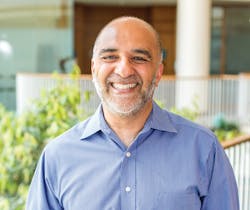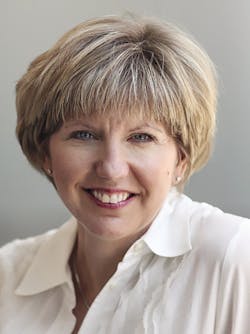When pundits write post-conference blogs about their experience at the annual HIMSS conference, they often identify common themes that emerged from the week of sessions, as though the hive-mind of 40,000 people came together and determined new paradigms or directions for the health IT community to go. But perhaps as interesting as reading post-mortems is asking industry leaders beforehand what they expect to hear about at HIMSS weeks before the industry descends on Orlando from March 9 to 13.
As Micky Tripathi, Ph.D., notes, last year the Office of the National Coordinator for Health IT (ONC) and the Centers for Medicare & Medicaid Services (CMS)released major draft rules on the eve of HIMSS and that ended up taking over a lot of conversations. “I hope that doesn’t happen again this year,” says the president and CEO of the Massachusetts eHealth Collaborative (MAEHC). “It sucked up a lot of the air in the room.”
In past years Tripathi has been involved in HIMSS presentations about the burgeoning FHIR standard and the Argonaut Project to develop clinical implementations, and those were standing-room-only sessions. So will FHIR be as hot a topic at HIMSS in 2020?
“I think there has been a little bit of a broadening effect,” Tripathi says. “We will see a lot more activities related to FHIR across vendors and many other initiatives, not just Argonaut. So the interest will be there, but more dispersed. There may still be a lot of interest in our session about FHIR accelerators, which include the Da Vinci Project, Gravity Project, Carin Alliance, and CodeX, which is focused on cancer.”
Tripathi predicts that besides FHIR and interoperability, people will also be talking about TEFCA, platforms and apps, but not blockchain. “There also may be people promoting ways to make price transparency possible.”
Another interoperability expert, Scott Stuewe, CEO of DirectTrust, says that at HIMSS he will be looking for the technologies and initiatives that are working to solve for the tensions between interoperability and other strategies. For instance, there is tension between adopting existing well-adopted standards (like Direct Secure Messaging and XDS) vs. emerging standards and technologies like FHIR and blockchain. “Another tension is between privacy, security and data ownership concerns vs. the desire to aggregate data from multiple organizations for analytics and allowing the patient access to their own health data,” he says.
Stuewe says he would be looking at identity proofing, resolution and matching companies as well as solutions and standards that enable interoperation at the data level—including distributed ledger technologies. “Initiatives, technologies and standards that could enable ‘scalable trust’ in the new FHIR app ecosystem will be hot as well,” Stuewe says. “Watching how the large cloud platforms will enable interoperable workflows will also be interesting.”
Among other activities, DirectTrust is sponsoring an Interoperability Showcase Connected Demonstration that will highlight six different technologies doing automated closed-loop referrals utilizing 360x over the DirectTrust network.
Stuewe says his strategy for walking the floor at HIMSS involves setting aside time to visit the list of companies that are new or are the result of mergers and take stock of who is missing as well and note the tensions on display.
David Muntz, a principal at StarBridge Advisors LLC and former health system CIO, is suggesting that CIOs heading to HIMSS should start thinking about changing their departmental group names from IT to Digital Services and their own title from CIO to chief digital services officer to signal that they are focusing on strategic decision making around technology. “My pitch is to make this change now and do it autonomously,” he says. “If not, you are going to be left in the past taking care of technology, which is reaching commodity status.”
Muntz says artificial intelligence and machine learning will be in virtually every booth you visit at HIMSS this year. Those AI and big data developments mean that managing data has become a real challenge. Also, social determinant data is going to cause data to be gathered from a wide range of sources and applications that aren’t being considered now. “Many people still don’t have a data governance process,” he says, “so I think you are going to see governance and compliance vendors offering to help people prove they are doing the right thing.”
A focus on social determinants
At HIMSS she expects to see companies describing how they will try to bring social determinant information into the EHR platform or other technology platforms for referrals, directories of community-based organizations or help with case management. “That is where social determinants really come to life when we have enough of a mature infrastructure to actively engage, screen, refer and support individuals in a community with what their needs are beyond medical.”
Wainwright is excited to announce that at HIMSS PCCI will be launching a book called Building Connected Communities of Care: A Guidebook for Connecting Medical and Community-Based Organizations Together.
The book will feature some lessons learned from PCCI’s Dallas experience standing up the Information Exchange Portal. The nonprofit organization has learned that beyond the technology, there are issues around governance, legal infrastructure, and working with community organizations and other health providers who might often be viewed as competitors. “I believe the HIMSS narrative will be largely focused on the technology aspects, which are of course incredibly important, but we have a strong point of view that technology without really good governance across all those players is only going to be marginally impactful,” Wainwright says. “So we hope to see some of the sessions focused on the idea that there are multiple different tracks of activity that have to happen in parallel to truly to have all the assets in place to effectively manage an individual’s health and non-health needs on an ongoing basis.”
In terms of looking for innovations at HIMSS, Wainwright will keep her eye out for two things. One is AI/machine learning. “In terms of where the envelope is being pushed,” she says, “I think it is going to continue to be in the artificial intelligence/machine learning piece of how we continue to extract value from very large data sets.”
The other thing she is looking for is how to scale success stories. “Shame on us as an industry if in our own markets we start to do the same things that seven other people have already been doing because we didn’t take the time or couldn’t figure out how to learn from them,” she says. “I view HIMSS and other large national platforms as a place to show what one group has done in a certain market so that people in the audience can take those insights back and either apply them in projects they are already doing or reach back out to those presenters and ask how to take what you have done and apply it so we can move forward in a much more efficient way.”
The role of HIEs
Another executive heading to HIMSS to both showcase the key role of health information exchanges and the need for more work on interoperability issues is Nick Bonvino, chief executive officer of Greater Houston Health Connect (GHH), which links more than 24 counties in Texas and Louisiana covering more than 15 million patients and 95 percent of the hospitals in that market.
Bonvino will be participating in a panel session focused on the successful collaboration of a Blue Cross and Blue Shield plan with GHH and their partner provider delivery systems to enhance value-based care and community health programs. They will focus on the HIE’s patient-matching utility, real-time alert system for member ADTs (admit, discharge and transfers) across state or county lines. The partners also plan to use electronic health information to mitigate social conditions by building capacity and better connecting members and communities through a clinical/social determinants of health information exchange.
He describes some of the topics the HIMSS panel will address. Bonvino notes that although patient identification sounds straightforward, it is actually a pretty challenging task. Even providers on the same EHR have trouble reconciling patient demographics. “To help solve this problem, at the HIE we do our matching and create a global or unique identifier for the HIE,” he explains. “We then send it to the provider organizations so they can put it in their system, so that when they are interacting with other providers, they can heavily weight that unique identifier for a better match.”
Payers and accountable care organizations (ACOs) are finding the HIE provides considerable value, Bonvino says. “If you are managing a population, the fact that a robust HIE like ours has 95 percent of the health systems connected puts us at the center of all medical activity. If you are a health plan or provider taking risk, you can send us a file of patients you want to monitor, and we can take that file and as those ADTs come in, send you real-time ADT notifications so you are aware of an activity going on with a member and your case managers can select which might be prioritized for follow-up.”
Bonvino says that at HIMSS he will be interested in hearing more about the ONC rule on information blocking as well as TEFCA. “We are very concerned,” he adds, “because we know that trying to do this nationally has its challenges.”
MAEHC’s Tripathi says one more thing to be on the lookout for at HIMSS are the EHR vendor app stores and the vendors writing plug-and-play, FHIR-based apps, especially patient-facing apps.
“The app store model is developing pretty well,” he says. “The market needs to develop a little bit more maturity. App vendors would say it is true that they can write a FHIR-based app and place it in the Epic, Cerner and Meditech stores. But they would also tell you that they have to do a lot of work with each EHR vendor, including contracting and working through user agreements. It is not a one-and-done process.”




